
Key Benefits of Using Magento 2 Pagination in Ecommerce
Are you looking for a way to make browsing easier for your customers? Magento 2 Pagination divides content into simple, user-friendly pages. It improves site speed and SEO and keeps users browsing longer.
This tutorial will cover the steps to optimize and the benefits of paging for ecommerce.
Key Takeaways
-
Effective pagination types for various store requirements.
-
Optimizing Adobe pagination in easy steps.
-
Paging vs. Infinite Scroll: What Sets Them Apart.
-
Why paging works best for ecommerce stores.
-
Creative alternatives to paging for online stores.
-
SEO tips for managing ecommerce pagination.
5 Types of Pagination Controls in Magento 2 Store
1. Default Pagination
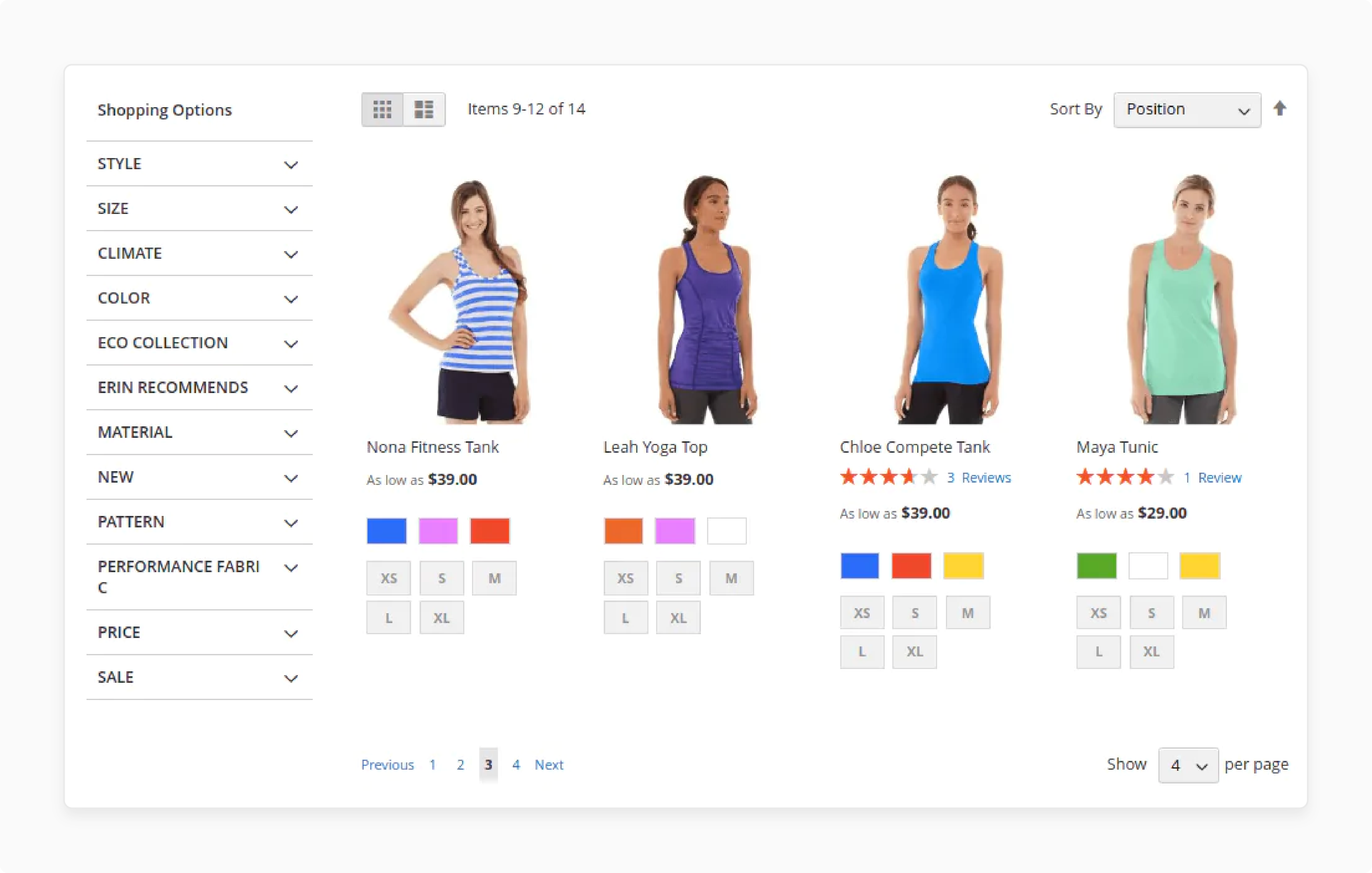
Default Magento uses a traditional paging system that makes navigation easy and intuitive. It includes page numbers, "Next" and "Previous" links, and options to jump to the first or last page. The method is simple to use and is a standard feature in pagination in Magento 2.
Features:
-
Page numbers for a clear menu between pages.
-
Links to move to the next set of links or previous pages.
-
Users can select the items displayed per page or scroll to the bottom of the product list.
2. Infinite Scroll
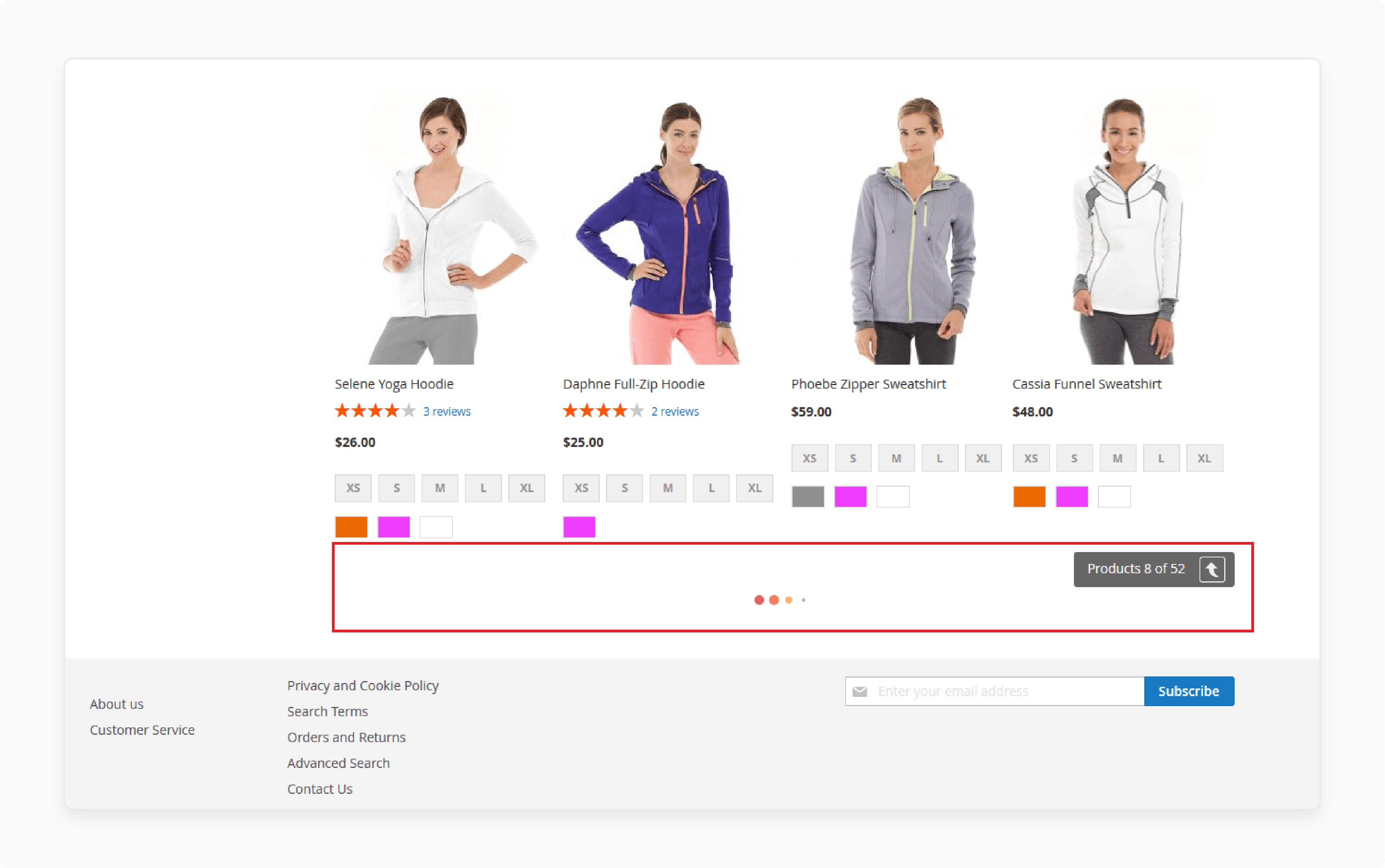
Infinite scroll loads more products as users scroll down the page. It is done without needing to click on paging links. It also breaks down content automatically, offering a seamless browsing experience. This works well for large catalogs, improving the speed and flow of the menu.
Features:
-
Automatically loads products as users scroll.
-
Eliminates interruptions and keeps the menu smooth.
-
Reduces loading time, making it ideal for extensive inventories.
3. Load More Button
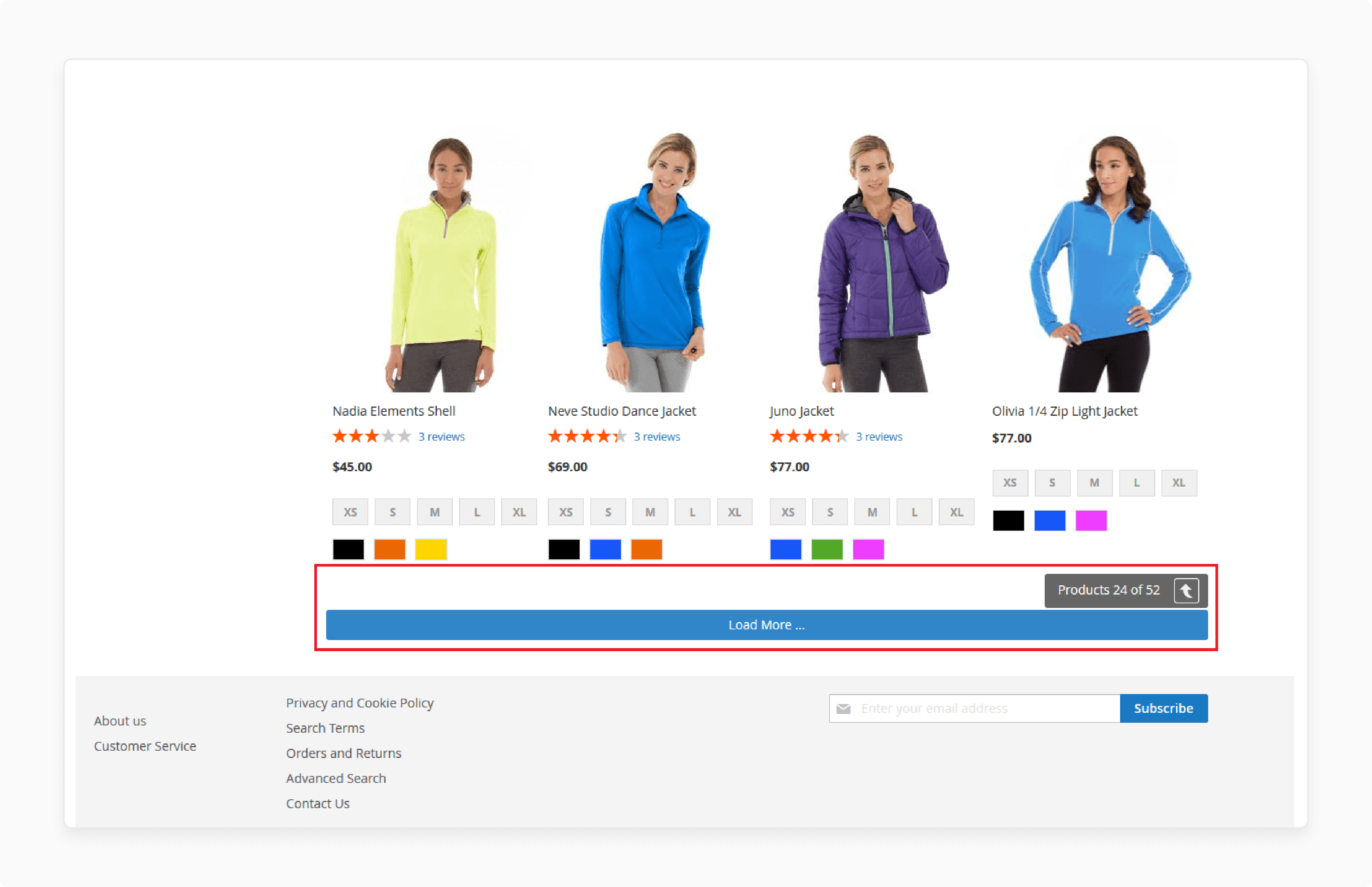
The "Load More" allows users to manually load additional products with a single click. It provides control over how many products are shown. It also helps to reduce the initial load size. This balances usability and performance optimization.
Features:
-
Users click to load more items on demand.
-
Keeps the pagesize manageable for faster initial loads.
-
Combines modern convenience with manual menu control.
4. Ajax Pagination
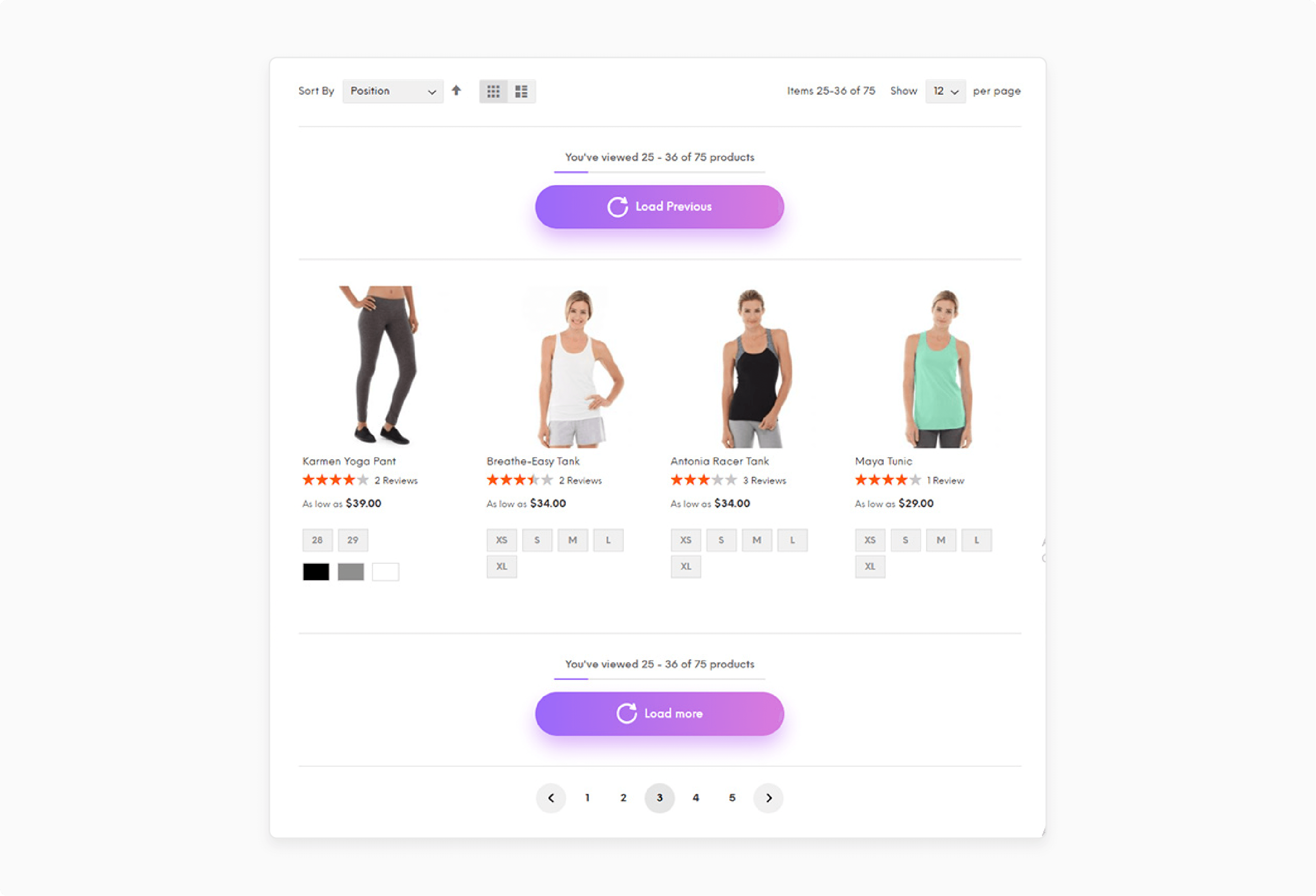
Ajax paging dynamically updates the catalog without refreshing the entire page. It uses php and a public function to handle asynchronous requests. This makes the browsing experience faster and smoother.
Features:
-
Updates the number of items displayed per section dynamically.
-
Reduces full-page reloads to improve efficiency.
-
Speeds up browse on the frontend, enhancing user satisfaction.
5. Custom Pagination
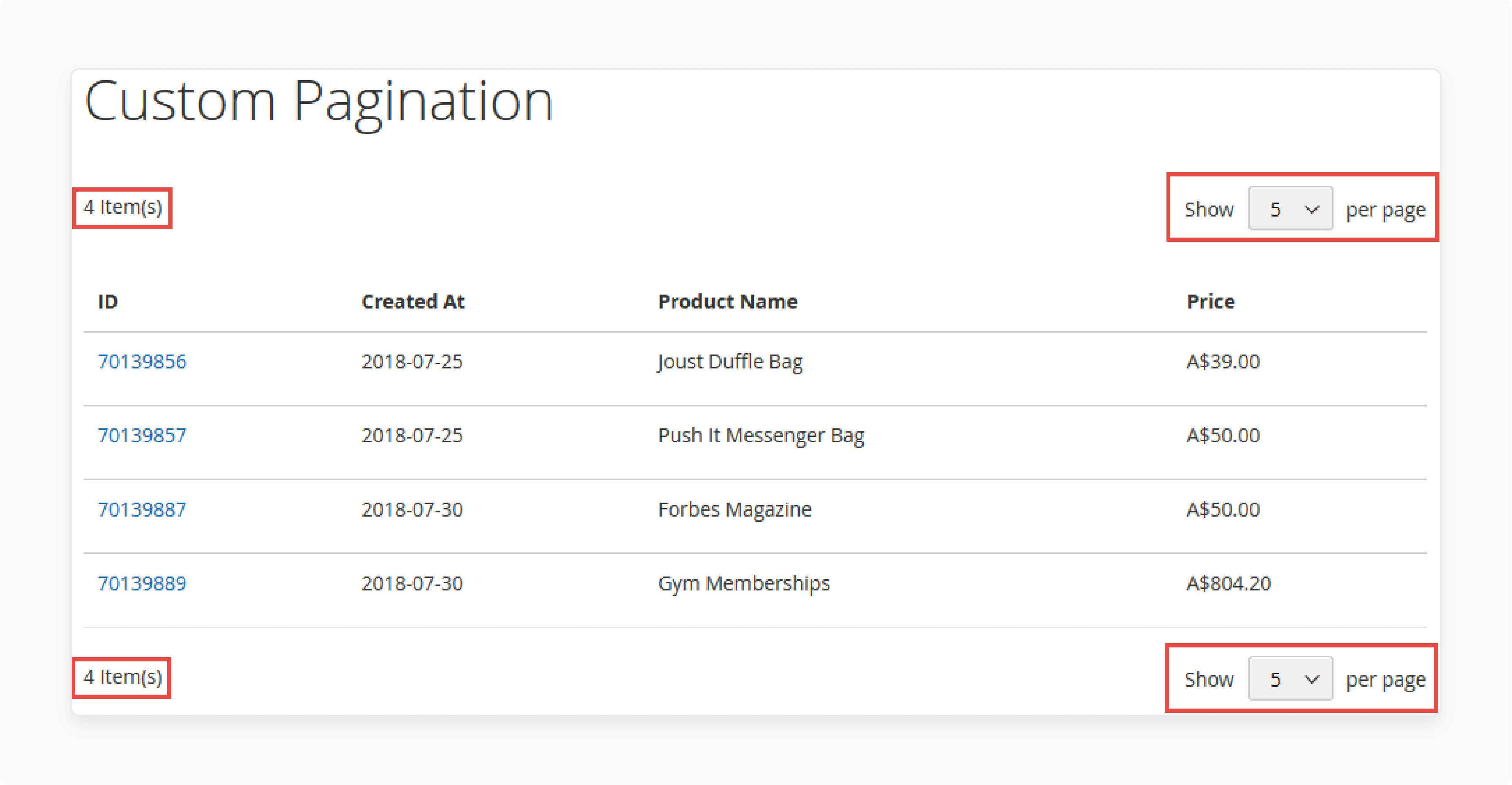
Custom paging is tailored for specific needs, offering unique menu styles. It supports advanced options like managing specialized collections or integrating with third-party tools. Developers can use this feature in custom module options for better usability.
Features:
-
Enables pagination to a custom group for specialized needs.
-
Compatible with magento\theme\block\html\pager for creating unique designs.
-
Offers flexible configurations for pagination settings in custom solutions.
4 Steps to Optimize Pagination in Magento 2
Step 1: Enable SEO-Friendly Pager URLs
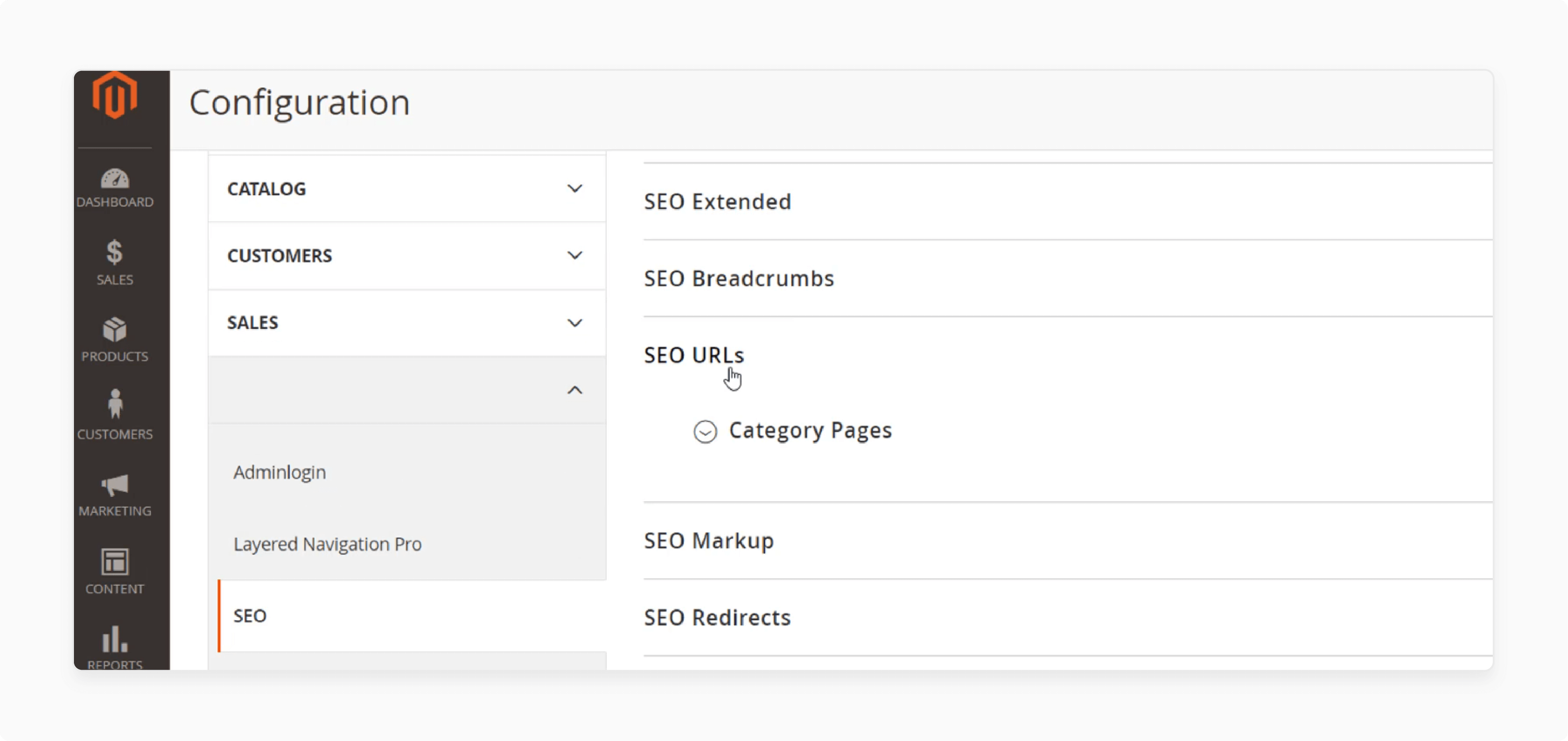
- Open Stores > Configuration > Extension Name > SEO > SEO URLs.
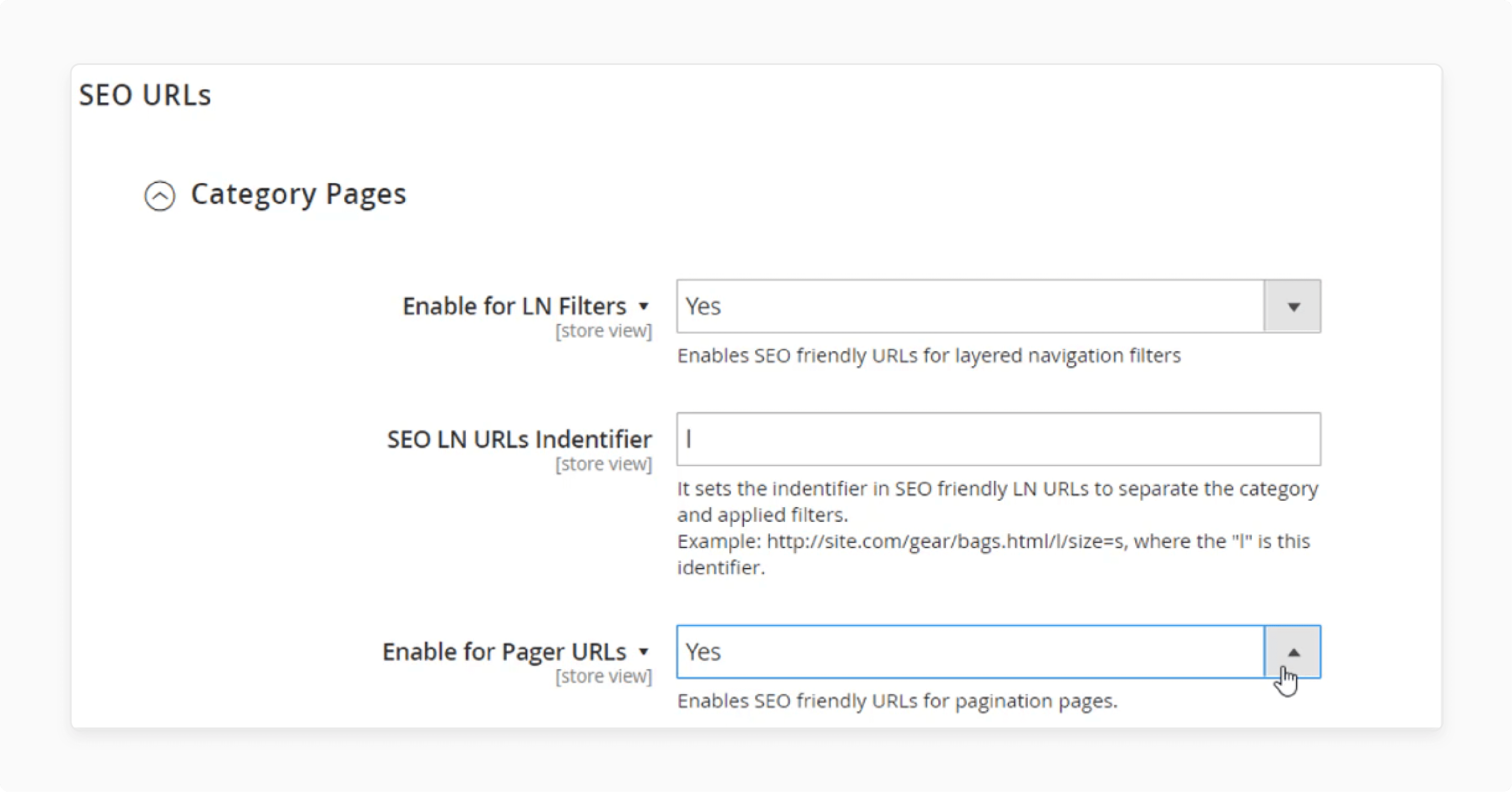
- Enable the "Pager URLs" option to create cleaner and search-friendly URLs.
Step 2: Choose the Pager Format

-
Select a format for pagination URLs.
-
Options include:
-
-[pager_var][pager_num] (e.g., your.online.store/category-p2.html).
-
/[pager_var]/[pager_num] (e.g., your.online.store/category/p/2.html).
-
Step 3: Customize the Pager Var Parameter

-
Adjust the pager parameter in the same section. The default value is p.
-
Replace it with a custom value that matches your online store’s structure.
Step 4: Add Pager Numbers to Meta Titles and Descriptions
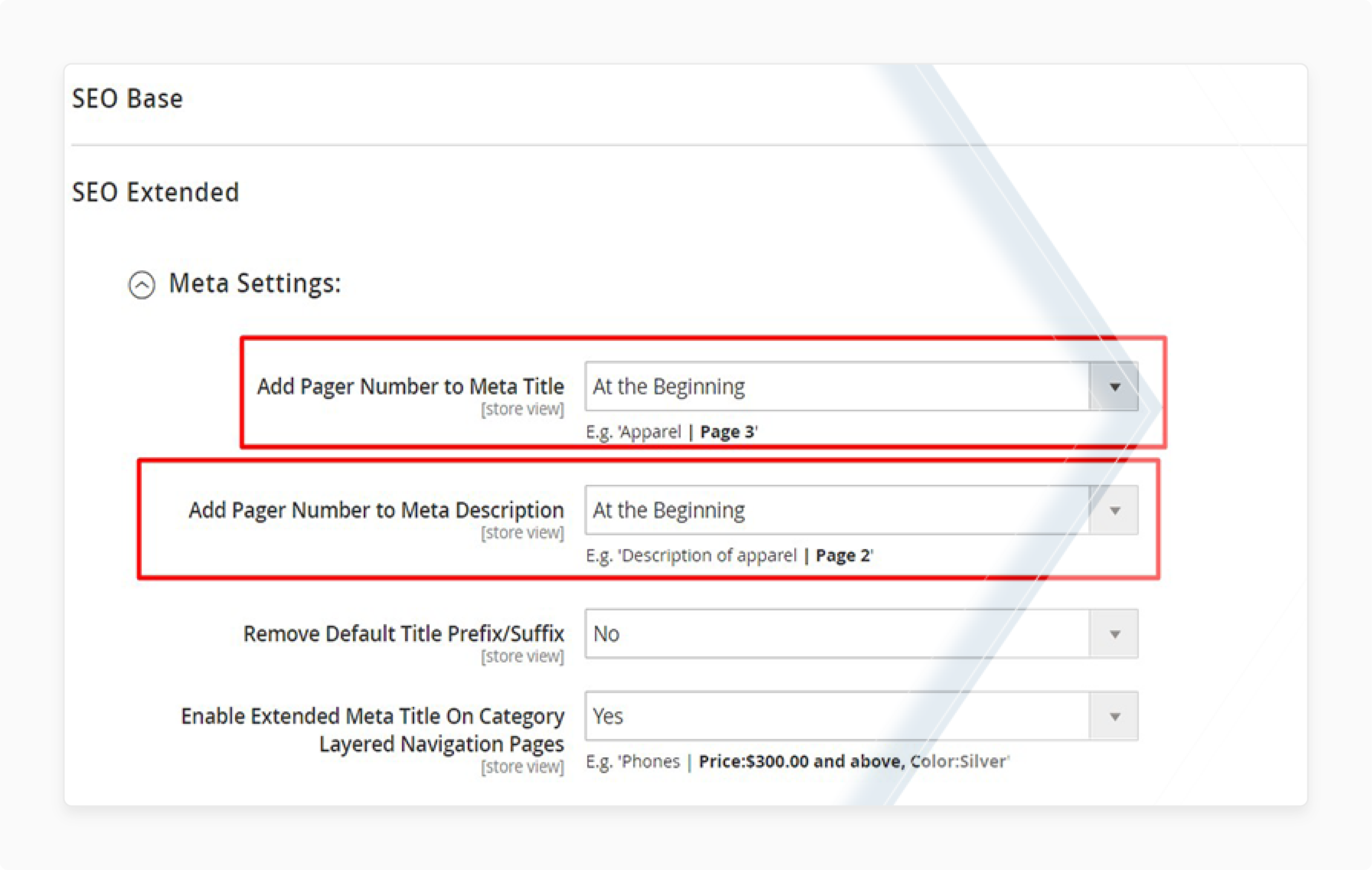
-
Go to Stores > Configuration > Extension Name > SEO > SEO Extended.
-
Configure the settings to add page numbers to meta titles and descriptions. This creates unique metadata and improves the customer experience.
Magento 2 Pagination vs Infinite Scroll: Key Differences
| Aspect | Pagination | Infinite Scroll |
|---|---|---|
| Navigation Method | Users can implement pagination with numbers, "Next," and "Previous" links in the pagination. The structure makes the menu clear and organized. | Automatically loads products as users scroll. It can overwhelm users if content into separate pages is not managed well. |
| Ease of Setup | Easy to set pages using the admin panel or while setting up pagination in a Magento store. | Requires custom coding or third-party extensions, making the setup more complex and costly. |
| Control | Provides users the ability to enter the number of pages they want to display per page. This offers more control and flexibility. | Does not allow direct control. It is harder for users to revisit specific sections. |
| User Experience | Offers a structured pagination facility that organizes products into manageable pages. The approach helps improve the user experience and reduces confusion. | Provides a seamless flow of products. It may frustrate users who cannot track their progress or see specific pages. |
| Performance | Loads a fixed number of products on each page. It reduces server load and ensures smoother browsing. | Continuously displaying the next set of products. It can increase server strain, especially for large catalogs. |
| Best For | Works well for stores with large catalogs. You can add pagination to improve usability in any ecommerce store. | Best suited for highly visual e-commerce sites where continuous scrolling is more natural. |
| SEO Compatibility | SEO-friendly, as Magento 2 allows clear and crawlable URLs for paginated pages. These pages also work well with analytics tracking. | Requires extra work to ensure content is crawlable. Without proper setup, infinite scroll can affect search results. |
| Drawbacks | Clicking through pages can take extra time. It prevents users from feeling overwhelmed by too much data at once. | It may overwhelm users, especially on slower devices or connections. It is due to constant loading. |
Key Benefits of Using Pagination in Magento 2 Ecommerce
1. Improved User Experience
With Magento pagination, large product catalogs are divided into smaller, manageable pages. This makes it easier for users to browse without feeling overwhelmed. For example, you can set the page size to show 20 items on each page instead of hundreds. It makes the shopping in your online store more user-friendly and enjoyable.
2. Enhanced Page Load Speed
Limiting the number of products on each page improves load speed. It is with the Magento 2 pagination set limit. Google considers page speed important for ranking. Faster pages also reduce bounce rates. It helps visitors stay longer instead of leaving after viewing just one page. Optimizing the pagination frame ensures smoother browsing and better performance.
3. Easier Indexing for Search Engines
Paging divides your website into smaller, easier-to-process sections. Search engines like Magento2 can crawl and index these sections more efficiently. Without this, large catalogs can overwhelm bots. By using tools like configure the pagination controls and newscollection. It makes your pages easier to index, improving rankings in search results.
4. Better SEO Control
Paging helps optimize each page in a Magento 2 custom collection with unique titles, meta descriptions, and keywords. Using configured pagination, you can target specific product categories or terms. It gives you control over search and makes your content the answer you're looking for. It also helps in boosting visibility.
3 Pagination Alternatives to Explore Better Ways to Display Ecommerce Content
1. Infinite Scrolling
Infinite scrolling extensions help in automatically loading content as users scroll down the page. It creates a smooth browsing experience without the need to click for more items. Infinite scrolling is engaging but requires careful planning. It helps to avoid usability and search issues.
Advantages:
-
Keeps users engaged with seamless content loading.
-
Ideal for smaller catalogs or visually rich sites like blogs or galleries.
-
It can be implemented with a protected function to ensure smooth backend performance.
Limitations:
-
Works best for small catalogs; large collections may overwhelm users.
-
Search challenges include indexing issues. It might struggle with continuously loaded pages.
2. “Load More” Button
The “load more” button combines paging and infinite scrolling. It lets users manually load more items without refreshing the page. The “load more” button is a versatile solution. It needs proper implementation to avoid search drawbacks.
Advantages:
-
Provides users with control over how much content they see at once.
-
Balances customer experience and search by keeping content segmented.
-
It works effectively when integrated with the smooth menu.
Limitations:
-
Creates a deep site structure if too many pages are generated.
-
Google might not index content hidden behind JavaScript-powered “load more” buttons.
3. “View All” Option
The “view all” option displays all content on a single page, making it easier for users to see everything at once. This method is suitable for smaller catalogs. The “view all” option works well for smaller catalogs. It may not scale effectively for larger ones.
Advantages:
-
Perfect for small catalogs where users can browse all products on one page.
-
It simplifies the menu and offers a complete overview of available items.
-
It uses PHP endif directives to prevent loading or rendering issues.
Limitations:
-
Viewing all options is not ideal for large catalogs as it can slow down page load.
-
It can overwhelm users with slower devices or connections.
Best SEO Practices for Ecommerce Pagination
1. Use Self-Referencing Canonicals
Adding a self-referencing canonical tag to each paginated page. It helps prevent duplicate content issues. The tag tells search engines that each page is unique and should be indexed properly.
Example: <link rel="canonical" href="https://www.example.com/page">
When adding a custom pages list. It includes sorting products in a custom group in Adobe Commerce and self-referencing canonical tags. It also helps search engines identify and prioritize the correct pages. Without these tags, similar pages may be treated as duplicates, causing indexing problems.
2. Use Clear URLs
Clear and descriptive URLs make the menu easier for users and search engines. Avoid confusing parameters and use the default URL structures. It ensures clarity and simplicity.
Example: https://www.example.com/category/page-2
These URLs help to improve the menu. It lets users easily find their position in the paging. Clear URLs make it easier for Google to understand the relationships between pages. It is important when you configure pagination controls in Magento.
3. Avoid Noindexing Paginated Pages
Do not use the "noindex" tag on paginated pages. It may block search engines from accessing valuable content. Use internal links to connect related pages, ensuring that search engines can index all your content.
Example: <meta name="robots" content="index, follow">
The approach distributes link equity across your site. It ensures that all content is crawlable. Avoid being without pagination instructions to guide search engines through your content.
4. Optimize Meta Tags and Titles
Each paginated page should have unique meta tags. It includes titles, descriptions, and H1 tags. This helps search engines understand the purpose of each page. It also prevents duplicate content.
How to Implement:
-
Create unique metadata for the first page manually.
-
Use templates for metadata on subsequent pages.
Example:
-
Title: Buy Smartphones in Canada - Page 2
-
Description: Find the top smartphones on the site. com that can be delivered to Toronto and other cities.
-
H1: Page 2: Smartphones
These meta tags are in Magento 2 pagination settings. It improves both usability and search engine visibility for paginated pages.
5. Internal Linking
Strong internal linking between paginated pages ensures better browse and crawlability. Link pages sequentially to maintain order and make content easy to find.
Example: Use "Next" and "Previous" links to connect paginated pages. For instance, link your test.news.pager from a blog post about winter accessories.
Internal links keep content connected. It improves the user menu and ensures search engines can crawl the full sequence of pages.
FAQs
1. How do I add pagination to an Adobe product list?
To add paging, go to the admin panel and navigate to Catalog > Frontend. Adjust the settings to define how many products appear on each page. It organizes your product catalog into smaller sections. This makes it easier for users to browse and improve their experience.
2. What steps are involved in adding pagination to a custom collection?
To add paging to a custom collection, use Magento's classes. Methods such as setPageSize() and setCurPage() divide your collection into smaller pages. It ensures faster page speed and a smoother browsing experience for users.
3. Can I configure pagination for specific pages in Magento 2?
You can easily set pages by editing XML layout files. Set parameters such as the count on each page within the file. The customization helps optimize paging for different sections. It ensures a tailored menu for specific user needs.
4. How do I configure pagination for CMS pages?
For CMS pages, you can use widgets or custom coding to add paging. Widgets help divide long content into multiple pages easily. Custom coding gives you more control. It helps to ensure paging aligns with your design and layout requirements.
5. How does paging impact Magento 2 performance?
Paginag enhances performance by reducing the count of items loaded on a single page. Smaller pages load faster, improving both customer experience and server efficiency. It is important for stores with extensive catalogs, as it ensures smooth browsing.
6. How can custom collections benefit from paging in Magento 2?
Paging organizes large custom collections by breaking them into smaller pages. This helps reduce page speed times and makes the menu more intuitive. It enhances the presentation of data. This improves the custom experience and usability of custom modules.
Summary
Magento 2 Pagination splits large datasets, like product catalogs, into smaller, easy-to-browse pages. It improves customer experience by simplifying the menu and speeding up page loads. Users can maintain a user-friendly structure for better usability. Consider the following benefits of paging:
-
Enhanced Page Load Speed: Limiting products on each page improves speed and performance.
-
Easier Indexing for Search Engines: Paging breaks large catalogs into smaller sections.
-
Better Search Control: Paging helps optimize metadata for each page.
Explore managed Magento hosting to enhance your store with optimized pagination.



